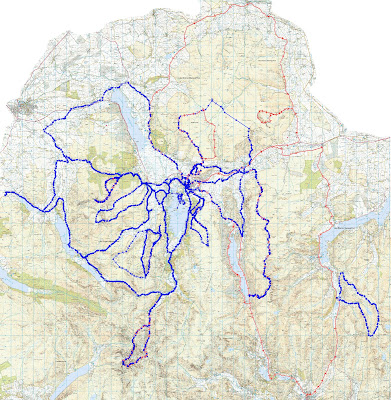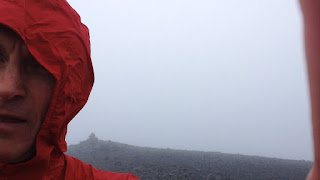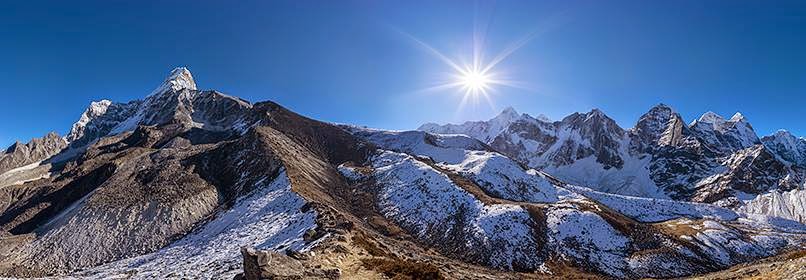Elsewhere I have covered the reasons why people fail on Everest but this article is about what you need to consider to even contemplate attempting it.
 |
| Everest from The North. |
There are seven keys elements that people require no matter which side of the mountain they are on, no matter which expedition they are with. These attributes have nothing to do with how much the expedition has cost, whether you are rich or poor, male or female. Altitude is the invisible enemy and it doesn’t differentiate.
 |
| Everest from The South. |
So … other than oxygen, Climbing Sherpas, a Base Camp cook crew, faultless logistics, the ability to get 8 weeks off work, the tricky issue of having sufficient budget to be able to afford it, the support of friends and family, the right amount of fitness etc etc what exactly do you need to be able to climb Everest :
1. ‘The Desire’
There is little point, if any, in attempting Everest unless you really, really want to do it. This should not be a whim of the moment decision. It’s not back of a fag packet type stuff*. It’s also not something that is on everybody’s bucket list and you don’t necessarily have to justify to anyone, except yourself, why you want to do it. You may not be able to vocalise how you feel about it. It may well just be something that, for whatever reason, ‘flicks your switch’.
But if you don’t have that yearning to attempt Everest then there is little point in setting out on it in the first place.
However … are you being realistic?
* Warning – smoking kills and is extremely bad for your health. Please do not take this an endorsement to start, or continue, smoking. Alternatively you could jot your idea down on the back of a beer mat**.
** Please note that drinking, even in moderation, can also be bad for your health. Perhaps best to just use a note book after all.
2. ‘Realistic ambition’
It’s all very well having the desire but is it realistic for you to be undertaking this massive challenge? Do you have what it takes? Should you perhaps be making it a 5 year plan to enable you to get the necessary pre requisite experience and enough time to save the money? Should you maybe have a think about it rather than making a knee jerk reaction having been inspired by a book that you have just read, a film you’ve just watched or a slide show you have just attended?
Having the desire is all very well but there are many things that we desire in life that we know won’t happen … unless we do something about it. And even then it may well be that the desire is completely unrealistic and even if you do try and do something about it it may well not transpire.
Don’t believe the public keynote speaker who uttered the ‘if you put your mind to it you can do anything’ line – that is utter rubbish. Have you ever noticed that this is a classic line that is banded around by people who have just done something? Yes you need to put your mind to it but don’t assume that you will achieve your ambition just because you want to have a go. You can’t just do anything that pops in to your head … or we would all be able to fly, see through walls, run a sub 3 marathon or teleport.
So perhaps you need to park the idea?
Or conversely you need to focus your energy in to getting prepared … as long as it is something that is actually realistic and potentially achievable.
3. ‘Experience and a high quality mountaineering resumé’
Preferably years and years of it. If you are naturally tuned in to the outdoor recreation environment due to the frequency, quantity and quality of your experiences then life on Everest will be a lot easier for you to tolerate. You shouldn’t have to think about whether your hood should be up or down, whether you are too hot or too cold, when to drink, where your gloves are or how the toggles work on your jacket. You should be able to anticipate environmental changes in advance rather than having to deal with them at the time. Preempting the fact that the sun is coming up, and in a quarter of an hour it’s going to be quite hot, has got to be better when you are stood in a safe place … rather than finding that you are boiling hot and needing to shed layers in a dangerous place fifteen minutes later. See the list of skills required elsewhere.
 |
| With years and years of experience and lots of expeditions under her belt Jen was very much in her element. Here she is approaching The South Summit. Shortly after this photo she stopped to change her oxygen bottle over and apply sunglasses and sun cream. She had gone a few minutes longer than she would normally after the sun comes up to allow her to get past a queue – but that was a sound decision on the day. |
4. ‘Technical expertise’
It’s all very well having a great resumé but be honest with yourself – are you an independent mountaineer in your own right or have you been guided on every trip and climb you have ever been on? In essence, if you have an extensive mountaineering cv but have solely been guided, this is not too much of a problem as long as you then sign up for a trip that has the correct level of guidance to cater for the shortfall.
Irrespective of that you still have to ask yourself whether you will ever end up in a situation where you are no longer guided (for whatever reason), high on the mountain and whether the implication of that terrifies you (it should do). Don’t bury your head in the sand and say that ‘it won’t happen to me’ because when it does and you are high on the mountain and alone you will feel very helpless and very lonely. It’s obviously not ideal but you should be able to cope in this situation.
Better to have a whole host of skills and a thorough understanding of the natural and ever changing environment, and how to adapt to it, than to be a potential liability to yourself and therefore a potential liability to everyone around you – including people on other expeditions. Knowing instinctively how to change your walking gait from one type of snow to another means that you won’t compromise yourself when the conditions underfoot change. Having a sixth sense about the weather, conditions, snow etc will mean that you are far less likely to jeopardise yourself and being tuned in will also make it a far more enjoyable experience as well. Knowing that your helmet should be on your head not your rucksack, knowing your routines and having faultless personal admin will all be very relevant when you are high on the hill.
 |
| I’ve said it before and I’ll say it again … this guy should not have been on Everest. Crampons on the wrong feet, a helmet on his rucksack instead of his head and a few useless quick draws on his harness. He didn’t even operate his jumar at each rebelay and his Climbing Sherpa had to do it for him. He was a liability to himself … and to everyone around him. |
5. The ability to Focus …
on what needs doing and when to do it. This applies to your years of training, your gear purchases, knowing your equipment intimately, your choice of operator and your own personal commitment. You need to focus on each and every aspect, and leave no stone unturned, whether it be research and preparation for the mountain, your fitness and gaining relevant experience prior to the expedition, or focusing on what is relevant at the right moment during the trip.
It’s really important to prioritise and realise that the consequences of your actions, or inactions, may have far reaching consequences. What would be considered to be small issues on lesser peaks become compounded issues on Everest. On lower peaks the fact that you haven’t applied or reapplied suncream may have little if any consequence. On Everest, due to the higher elevation and the rarified atmosphere you will frazzle and become sunburnt which is extremely debilitating. In the UK you can perhaps get away without drinking for the whole day (with the intention of topping up when you get home). On Everest you won’t be able to get enough fluids to be sufficiently rehydrated if you go in to deficit. A little bit of dehydration on a daily basis will become a massive problem at the end of a 7 or 8 week period and you will be not only debilitated but also much more prone to the effects of high altitude, more susceptible to frostbite and hypothermia as well as having reduced efficiency and depleted brain function.
Look at your expedition as a long term project. It requires lots of preparation and it needs to be conducted in a manner where you are constantly reevaluating the situation. Do your due diligence not only of the company that you are going to sign up with but of yourself as well.
 |
| Giles at the top of The Geneva Spur en route to the summit. A few days earlier he had contemplated going home. Thankfully he was able to refocus his energies and turned his feelings of despondency in to drive and determination. |
6. Mental tenacity
You need this by the pound. There will be moments of self doubt. There will be the days when you just don’t perform how you hoped. There will be the off days when you should be firing on all cylinders. There will be the days when you are missing your friends and family and questioning this crazy endeavour. And combined with all that … you will have a headache at some stage, possibly a bout of diarrhoea, your lips may well have cracked because you weren’t looking after yourself, you can’t sleep properly at night because of sleep apnoea, it’s cold and you pee all the time and you will go off your food. Perversely, just when you are burning more energy than you have ever burnt before, you will lose your appetite and won’t be able to face a fork full.
How on earth can you attempt to continue unless you have mental tenacity by the bucket load? However, you must temper your resilience with a deep respect for the environment around you and also listen to the inner you. If it doesn’t feel right then that 6th sense of yours may well be worth listening to. If you continue because your are tough and resilient, whilst ignoring the very obvious changes that are happening around you, then your mental tenacity may well get you in to trouble.
Mental tenacity has to be balanced with a respect for the conditions around you and a certain feeling of vulnerability.
7. Self belief
This is a slightly different psychological requirement. Being tough and mentally resilient is one thing but you will need to be able to keep on going, despite how awful you feel, in spite of how lonely you might be, no matter how ‘out there’ and vulnerable you may feel. You have to put all that to one side and put one foot in front of the other … incredibly slowly … believing all the way that you have what it takes. Again, as with mental tenacity, your self belief has to be tempered to the surroundings, and any changes that may be occurring, or it may well get you in to a pickle.
 |
| Put it all together and you may, just may, get to the summit. |
So there you have it – a variety of key traits that you need to have a chance of being successful on Everest. But remember – just because you have the ambition, the drive, the focus and all the other necessary prerequisites doesn’t actually mean that you will achieve your target.
No matter which expedition you sign up for, no matter how much preparation you have done, no matter how good your Climbing Sherpa is you have to remember that only you can put one foot in front of the other – it can’t be done for you.
Time to get out on the hill.
(For further related reading have a look at the suggested Skills Required and Why People Don’t Summit).


























